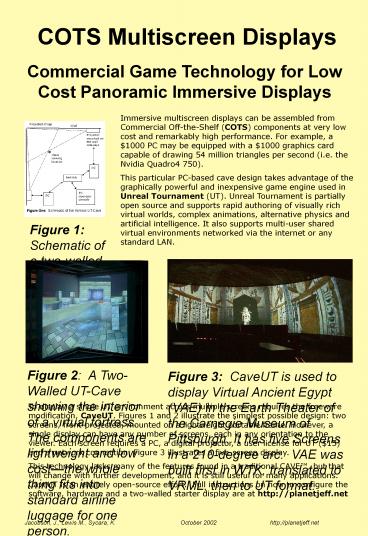COTS Multiscreen Displays - PowerPoint PPT Presentation
Title:
COTS Multiscreen Displays
Description:
This particular PC-based cave design takes advantage of the graphically powerful and inexpensive game engine used in Unreal Tournament (UT). – PowerPoint PPT presentation
Number of Views:46
Avg rating:3.0/5.0
Title: COTS Multiscreen Displays
1
COTS Multiscreen Displays
Commercial Game Technology for Low Cost Panoramic
Immersive Displays
Immersive multiscreen displays can be assembled
from Commercial Off-the-Shelf (COTS) components
at very low cost and remarkably high performance.
For example, a 1000 PC may be equipped with a
1000 graphics card capable of drawing 54 million
triangles per second (i.e. the Nvidia Quadro4
750). This particular PC-based cave design
takes advantage of the graphically powerful and
inexpensive game engine used in Unreal Tournament
(UT). Unreal Tournament is partially open source
and supports rapid authoring of visually rich
virtual worlds, complex animations, alternative
physics and artificial intelligence. It also
supports multi-user shared virtual environments
networked via the internet or any standard LAN.
Figure 1 Schematic of a two-walled immersive
display. CaveUT allows up to 32 screens.
Figure 2 A Two-Walled UT-Cave showing the
interior of a virtual fortress. The components
are lightweight and low costthe whole thing fits
into standard airline luggage for one person.
Figure 3 CaveUT is used to display Virtual
Ancient Egypt (VAE) in the Earth Theater of the
Carnegie Museum of Pittsburgh. It has five
Screens in a 210-degree arc. VAE was built first
in WTK, translated to VRML, then to UT format.
To display a single UT environment across
multiple screens requires the freeware
modification, CaveUT. Figures 1 and 2 illustrate
the simplest possible design two screens,
front-projected, mounted on a lightweight
portable frame. However, a single display can
have any number of screens, each in any
orientation to the viewer. Each screen requires a
PC, a digital projector, a user license for UT
(15) and a network connection. Figure 3
illustrates a five-screen display. This
technology lacks many of the features found in a
traditional CAVE, but that will change with
further development, and it is still useful for
many applications. CaveUT is an entirely
open-source effort. Full instructions on how to
configure the software, hardware and a two-walled
starter display are at http//planetjeff.net
Jacobson, J., Lewis M., Sycara, K.
http//planetjeff.net
October 2002































